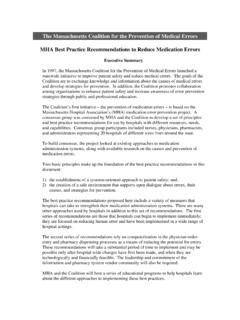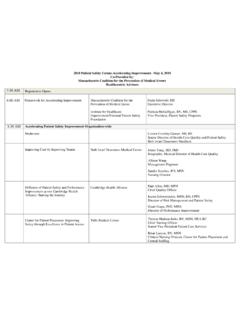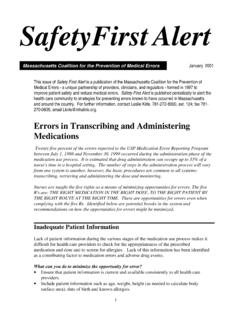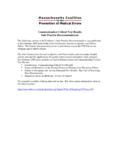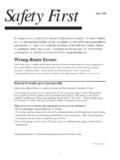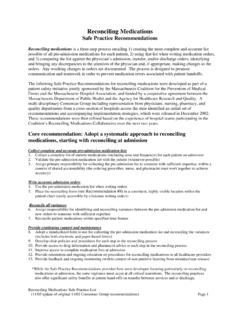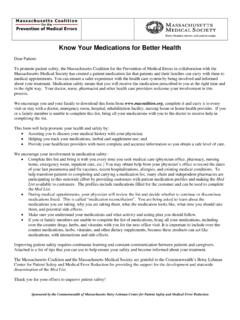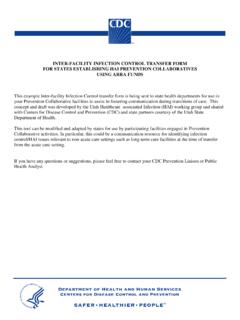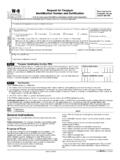Transcription of A Systems Approach to Quality Improvement in Long-Term ...
1 A Systems Approach to Quality Improvement in Long-Term Care:This project is funded by the Betsy Lehman Center for Patient Safety and Medical Error Reduction and the Massachusetts Department of Public medication practices WorkbookProject Director: Patrick O Reilly, PhD, MPHE dited by:Yvonne Michaud, MS, RN Assistant Project DirectorContributing Authors:Laurie Herndon, MSN, APRN, BCProject ConsultantJane Niemi, MSN, RN, LNHAL ayout and Design:Lorraine DeVaux, Graphics SpecialistBetsy Lehman Center for Patient Safety and Medical Error ReductionA Systems Approach to Quality Improvement in Long-Term Care: safe medication practices workbook 2007 Property of the Commonwealth of Massachusetts Page 2A Systems Approach to Quality Improvement in Long-Term Care: safe medication practices WorkbookTable of ContentsHow to Use This workbook .
2 5 Acknowledgments ..7 Introduction to the safe medication practices workbook .. 10 Tab 1 - Organizational Commitment to medication Safety .. 15 Importance of Leadership Commitment .. 16 Creating a Culture of Safety Key Points .. 21 system Plan of Action - medication Error Prevention .. 22 Checklist for Action Planning .. 23 Reduction in medication Errors in Long-Term Care Facilities .. 23 Tab 2 - medication Management Policies .. 24 medication Management Policies: Key Points .. 25 Checklist for medication Management and Policies .. 26 Tab 3 - Educating Staff.
3 31 Planning Learning Activities .. 32 Establish Learning Outcomes for safe medication practices .. 32 Case Study as a Teaching Strategy .. 32 Checklist for Assessing Staff Education and Training .. 34 Principles of Adult Learning .. 42 Checklist: medication Administration Competency .. 51 Tab 4 - Prescribing .. 52 The Prescribing Process ..53 Types of Prescribing Errors .. 53 Lack of medication Knowledge Increases Prescribing Errors .. 53 Drugs Frequently Associated with Adverse Drug Events .. 53 Components of a Complete medication Order.
4 54 Checklist for Assessing medication Use Process: Prescribing .. 56(Continued)A Systems Approach to Quality Improvement in Long-Term Care: safe medication practices workbook 2007 Property of the Commonwealth of Massachusetts Page Tab 5 - Documenting Transcribing .. 74 Transcription /Documentation .. 75 Factors Affecting 75 Checklist for Assessing medication Use Processes: Transcribing .. 77 Steps to Consider to Reduce Transcription Errors .. 78 Tab 6 - Dispensing .. 79 Dispensing ..80 Checklist for Assessing medication Use Processes: Dispensing.
5 82 Tab 7 - Administering .. 83 medication Administration .. 84 High-Alert Medications ..84 Administration Tips ..85 Checklist for Assessing medication Administration Processes: .. 86 Tab 8 - Monitoring .. 99 medication Monitoring .. 101 Types of Monitoring Errors .. 101 Types of Adverse Drug Events Related to Monitoring .. 101 Any New Symptom Should Prompt Evaluation for Adverse Drug Event .. 102 Monitoring for the Use of Unnecessary 102 Risk of Adverse Drug Events Increases as Number of Medications Increase .. 102 Tools and Measures for medication 102 Monitoring for Appropriate Discontinuation of medication .
6 103 Who is Responsible for medication Monitoring? .. 103 medication Monitoring and Technology .. 103 High-Risk Drugs and medication Monitoring .. 103 Checklist for Assessing the medication Use Process: Monitoring .. 105 Tab 9 - Error Tracking and Analysis .. 115 Improving the Safety of the medication Use Process and Creating a Culture of Safety .. 116 Error Tracking and Analysis .. 116 Making the Most of the Incident Report .. 117 Near Misses ..117 National medication Error Reporting .. 118 Additional Methods of Error Detection.
7 118 Tab 10 - Quality Improvement .. 126 Rapid Cycle Change Model .. 143 Data Tracking Tool ..145(Continued)A Systems Approach to Quality Improvement in Long-Term Care: safe medication practices workbook 2007 Property of the Commonwealth of Massachusetts Page Tab 11 - Warfarin .. 151 Warfarin Audit Tool ..160 Tab 12 - Reconciliation .. 168 Incident Reporting of medication Errors - STEP 1 .. 170 Tab 13 - Monthly Edits .. 180 The Process ..181 The Problem ..181 Effective practices for Monthly Edits .. 181 Workload Issues ..182 Issues with the Editing Process.
8 182 Environment ..183A Note About House Stock Medications .. 183 Sample Monthly Edit Procedure .. 184 Checklist: Monthly Edits .. 185 Tab 14 - Educating Residents and Families .. 186 Tab 15 - Resources and Regulations .. 196 National Organizations .. 197A Systems Approach to Quality Improvement in Long-Term Care: safe medication practices workbook 2007 Property of the Commonwealth of Massachusetts Page How to Use This WorkbookThis resource manual outlines a medication management system in Long-Term care. Each of the 15 tabbed sections focuses on specific processes that make up the system .
9 Each tab includes an explanation of the material found within the tab. Tools that apply to the particular section are listed, as well as Reminders and Resources to assist the reader in moving through the various sections. Improving outcomes with regard to medication errors and adverse drug events requires assessment and planning within the major areas of focus addressed in each tab. As you work through the sections, determine your facility s needs and the areas that are your priorities for Areas of Focus:Tab 1 Organizational Commitment to medication SafetyTab 2 medication Management PoliciesTab 3 Educating StaffTab 4 PrescribingTab 5 Documenting - TranscribingTab 6 DispensingTab 7 AdministeringTab 8 MonitoringTab 9 Error Tracking and AnalysisTab 10 Quality ImprovementTab 11 WarfarinTab 12 ReconciliationTab 13 Monthly EditsTab 14 Educating Residents and FamiliesTab 15 Regulations and Resources There are a number of Web site listings in the workbook where you can access additional tools and materials.
10 If you want direct access to these sites, you can view this workbook online at When you come to a Web site in the workbook that you want to visit, simply click on the URL (the address of the site), and you will be sent there directly. A Systems Approach to Quality Improvement in Long-Term Care: safe medication practices workbook 2007 Property of the Commonwealth of Massachusetts Page IntroductionIn 2005 Masspro, the Massachusetts Extended Care Federation (MECF), the Massachusetts Coalition for the Prevention of medication Errors (Coalition), and the Betsy Lehman Center for Patient Safety and Medical Error Reduction (Lehman Center) initiated a project with funding from the Lehman Center and the Massachusetts Department of Public Health.
